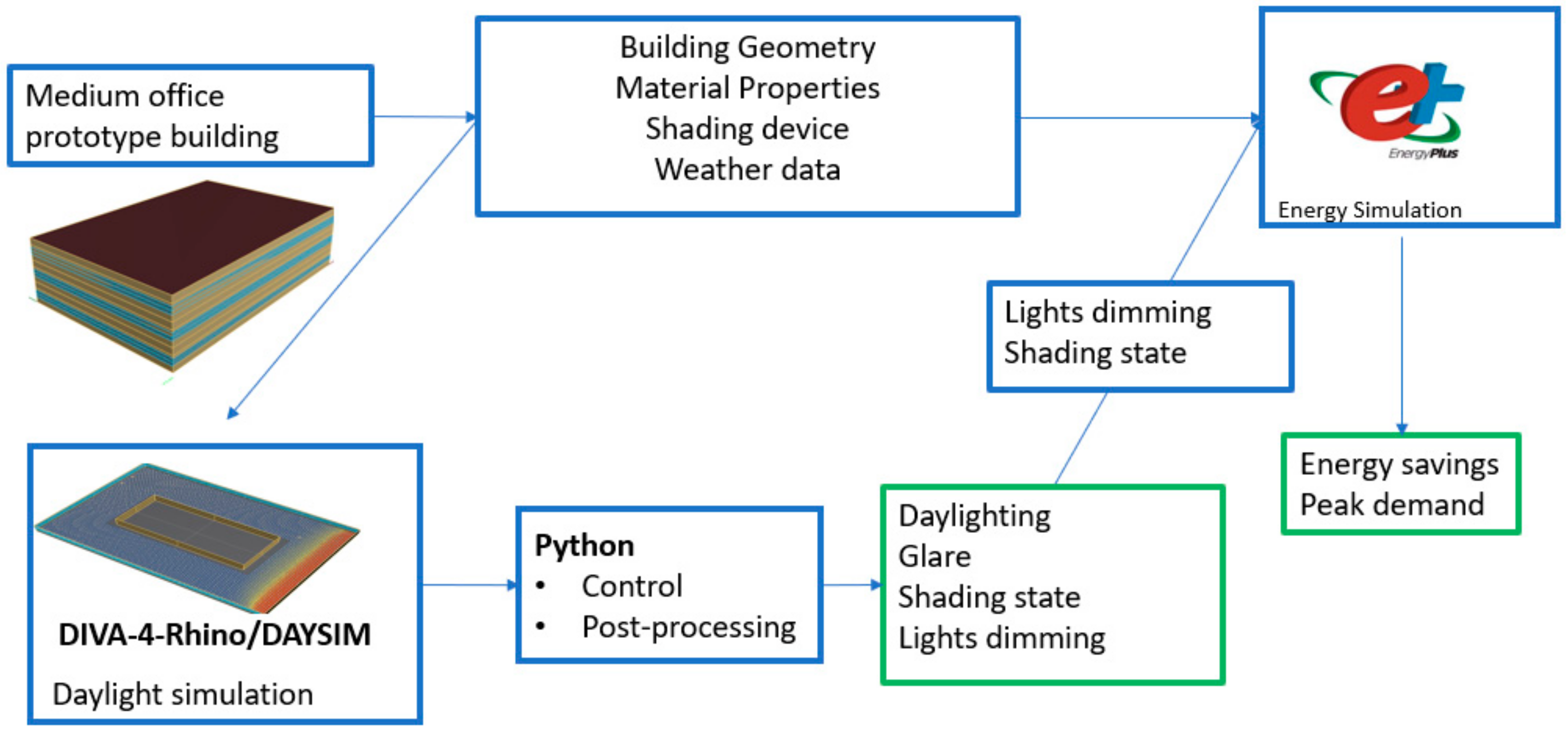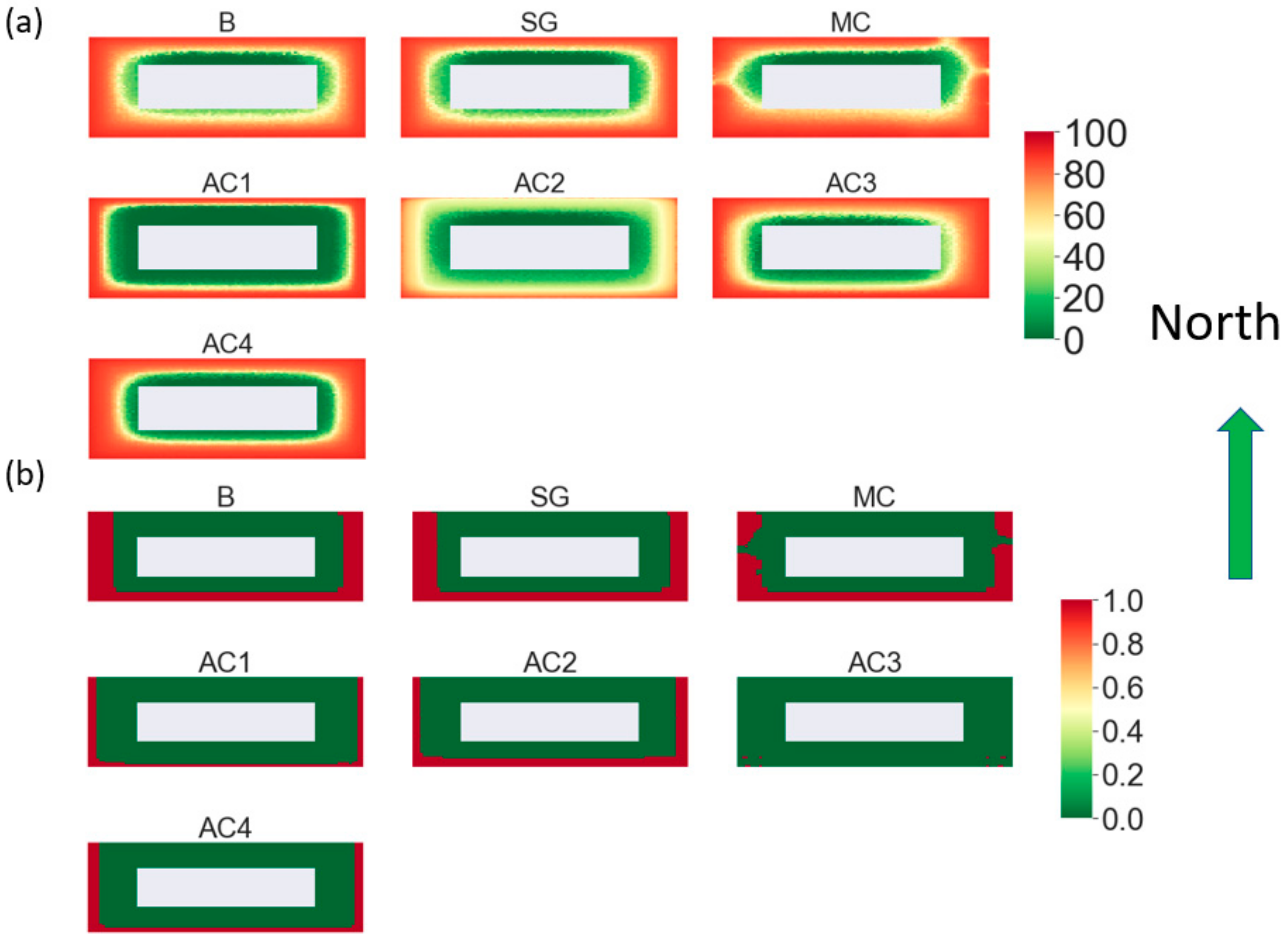1. Introduction
Commercial buildings in the United States (US) consume approximately 1.9 EJ of energy; heating, cooling, and lighting applications account for 50% of this demand [
1]. A study estimated that 34% of the total heating and cooling energy consumption by commercial buildings in the US is due to heat gain and loss through windows [
2]. Solar heat gain is the major and most variable cause of cooling energy demand. Solar heat gain and daylight also affect occupant thermal and visual comfort, well-being, and productivity [
3,
4]. Shades and blinds are a cost-effective means to reduce energy loss due to windows and provide a comfortable environment in the building, and they are easy to install [
5]. However, appropriate operation of the shading is required to satisfy both objectives, reducing energy consumption and maintaining occupant comfort. Most shades and blinds are manually operated, and the frequency of adjustment is limited. A study found that 50% of manually operated shades in six commercial building were never moved during a 16 day observation period [
6]. Automated shades can overcome the limitations of manual control and provide a balance between energy efficiency and occupant comfort.
Several research efforts have been carried out on different types of shading devices and control methods. Some studies have focused on the characterization of shading types for daylighting and thermal performance. A model for determining off-normal properties of roller shades was developed [
7] based on experimental measurement of roller blind properties. Similarly, a method of calculating the solar optical properties of Venetian blinds was developed [
8]. Different methods of characterizing the thermal and optical properties of a combination of glazing and shading layers, known as a “complex fenestration system,” have been discussed [
9]. Other studies have controlled shading devices using energy and daylight simulation tools. EnergyPlus™ simulation was used to determine the energy savings from roller shades operated using different solar radiation set points in a private office space [
10]. Different glazing systems were assessed with three different shading controls for energy, daylighting, and glare performance [
11]. Two window sizes, two orientations, and three glazing types were simulated for the evaluation using an open plan office building. Another study analyzed 64 cases with 16 different settings of perforated solar screens to examine the relationship between daylight availability and annual energy consumption [
12]. In that study, a shoebox model was used for analysis, with energy consumption based on cooling and heating loads. Similarly, a parametric study was performed using a single shading control available in DAYSIM (V3.0, MIT Sustainable Design Lab, Cambridge, MA, USA) to analyze geographic location, room orientation, room depth, window-to-wall ratio, optical properties of glass, and external obstructions [
13].
Some research has focused on experimental testing of shading devices and the resulting energy consumption, or/and daylighting. Automated roller shades were used to evaluate their impact on lighting energy consumption [
14]. Recently, experimental testing of integrated shading and lighting control found 35% overall energy savings during the cooling season [
15]. Experiments also were conducted to test the new technology of high–dynamic-range image-based control of shading devices [
16]. Cellular shades have been tested in laboratory homes to evaluate their energy performance [
17]. Integration of photovoltaic (PV) energy systems with Venetian blinds has been performed to reduce lighting energy and optimize PV power generation [
18]. Novel methods for evaluating daylight glare probability (DGP) using vertical illuminance measurement and luminance maps solely based on direct component of light sources were explored [
19]. Model-based control was used to study the impact of shading devices, with a focus on daylighting [
20].
However, the control strategies used in most of these studies are hypothetical strategies and not the types of shading control strategies used by the shade automation industry, which generally are more complicated to simulate. Simulation studies have controlled shading devices based on numerous default control strategies available in software like EnergyPlus™ (V9.0, US DOE, Washington D.C, USA) [
21] and DAYSIM [
22], but such studies may not represent a large set of realistic control strategies for use in real buildings. For example, results from some studies have claimed lighting energy savings of up to 81% [
10] and cooling energy savings as high as 85% [
23]. These high savings might be due to the fact that in both [
10] and [
23], the shades were either fully closed or open and do not consider shades at intermediate heights. Moreover, the realistic industry standard shade automation strategies for preventing glare and providing visual comfort were not deployed. The unavailability of accurate information on the performance of existing shade controls might hinder the market penetration of shading devices and their benefits, such as energy savings, visual aesthetics, and potential demand response. Thus, there is need to evaluate generic shading control strategies to predict their impact on energy consumption and daylighting more reasonably. Although efforts have been made to integrate energy and daylighting simulations [
24,
25], many studies focus solely on the energy impact [
10,
23] or on the daylighting performance [
26,
27] of shading alone and do not evaluate the detailed integrated performance. Moreover, most of the studies that address both energy and daylighting benefits are limited to single-zone [
15,
28] so evaluation of their potential impact at the whole-building level is limited. To the best of the authors’ knowledge, there has been no comprehensive study using integrated energy and daylighting performance for actual control systems, or shading devices in commercial buildings for different climatic conditions.
We address herein these gaps in the study of shading attachments and evaluate the potential impact of shading devices on energy consumption, daylighting, visual and thermal comfort, and shade operation for medium office buildings. An integrated daylighting and energy simulation approach was adopted. The study was conducted for three different types of commercial buildings—a large hotel, a secondary school, and a midrise apartment building—but for the sake of brevity, only the methodology and results for the medium office building are presented in this paper. Different shades and control strategies were used for a comprehensive evaluation in the building. The method of using integrated daylighting and energy simulation is not a novel concept for examining shading systems and controls. But to address the gaps described above, a comprehensive study is needed to study the performance and impact of shading systems and actual control systems in common building types. Hence, typical shading devices used in office buildings and different control strategies used in the attachment industry were simulated to evaluate their performance. The results for energy consumption were observed at the building level; and for daylighting, results for a single floor (middle floor) were taken as a representative case for all floors, which had identical geometry and surface reflectance properties. The following section provides the methodology used for the energy and daylight simulations and the details and implementation of the control strategies used. Results and discussion are provided in the subsequent section, followed by the conclusions of the study in the final section.
4. Conclusions
Various control strategies used for shading devices were evaluated for their impact on energy consumption and/or daylighting for three vintages of a prototype office building in six different US locations. The modeled control strategies, including complex control systems, included nine different cases for a medium office building. Daylighting results were presented for all the cases using roller shades and the baseline case, and results for energy consumption/savings were also provided for Venetian blinds and secondary glazing. The conclusions that can be drawn from this study are as follows:
The results indicate that integrated shading and lighting controls have a high energy benefit compared with a baseline case with no shading devices or lighting control. Overall energy savings of up to 28% were achieved using the integrated controls, while using AC3 control using an exterior shade.
Variations in performance were observed for different locations and different shades and control strategies. For example, higher energy savings were observed in cooling-dominated than in heating-dominated climates. Hence, control strategies that account for the impact of different climatic conditions might be able to realize more energy benefits.
The control with exterior shading (AC3) showed the best performance in cooling-dominated climates and SG performed best in heating-dominated climates in terms of energy savings. Both AC3 and SG showed good potential for peak shaving.
Using internal shading devices (with similar properties), energy savings varied with the control strategy (AC2 showed lower lighting energy savings and higher cooling energy savings compared with AC1 and AC4).
SG had good energy savings and peak shaving potential but had poor performance for glare reduction.
Results showed that glare could be mitigated using automated control strategies and shading devices, and careful selection of shading devices and control strategies is required to achieve these objectives.
External shading had better performance for daylighting harvesting and glare prevention.
Shading devices with very high VT do not provide glare prevention.
Shade operation with the same shading device can have varying impacts on energy consumption and daylighting (AC2 had higher cooling energy savings, lower lighting savings and poor daylight harvesting compared with AC1 and AC4).
These results from different shading control strategies can be used to enhance the performance of shading devices/shading controls by modifying the shade properties/control algorithms that are practical in real-world scenarios. These control algorithms can also be used as a basis for comparison with new control algorithms in terms of energy performance, daylighting, and shade operation.
Although this study presents a comprehensive overview of the impact of numerous shade control strategies on different building types in locations with different climatic conditions, it has some limitations. A single material was used for the roller shades; more products can be explored to observe how a different range of products changes the performance of different control strategies. Another limitation of this study is that it does not account for user interaction with or override of the automated controls. That factor might impact the performance of the shading devices; however, considering occupant behavior would increase the complexity of the study excessively. Occupant interaction might provide more insight if it were studied using individual case studies and not as part of a performance evaluation such as this one. A next step in characterizing the performance of shading devices in various built environments might be studying the effects of occupant behavior on energy performance.















